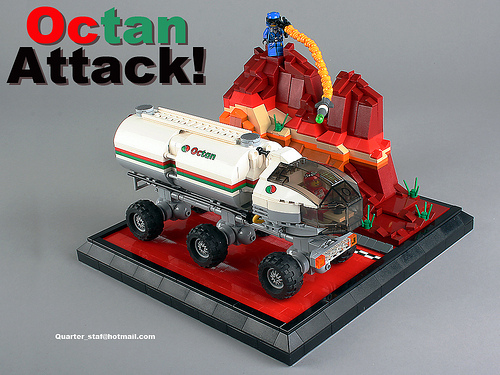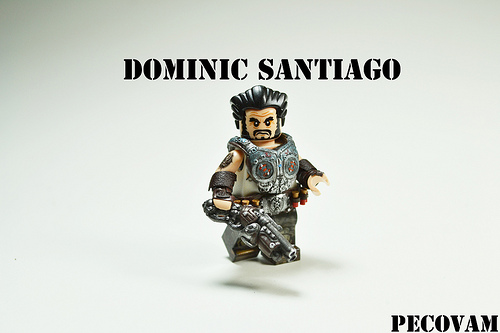LegoBucket puts a spacefaring twist on a classic fairytale with this scene, in which a spaceman finds a comfortable place to lay his weary head. Little details like the plant on the dresser, hat on the smallest alien, and gloves on the floor make the scene.
Monthly Archives: March 2012
Dune (not the book/film)
While I like George Panteleon’s (ZetoVince) car models, I especially like his presentation. Check out the dunes!

We study mathematics here
Jason Allemann (True Dimensions) is an alumni of the University of Waterloo. And apparently his time there was spent peering at the Mathematics and Computer Science building (in which he had only one class) as he has recreated it beautifully in LEGO. It’s microscale, but it’s a very big building.
Check out the trees.
Stunning Modern Architecture
I’m not generally a big fan of minimalist architecture, but occasionally I find myself surprised when viewing a particularly elegant example, such as this minimalist home by flickr user LegoManiac/oLaf. The colors complement each other remarkably well, and the shape of the Lego brick lends itself so well to this aesthetic. The design of the wood deck, with vertically oriented brown tiles, is genius, and take careful note of the pool, which is really filled with water.
Terrorism on Mars!
Everybody loves Octan. Well, maybe not the Lunar Separatists, as Mark Stafford (lego_nabii) shows in this lovely diorama.
The Martian strata is particularly excellent, but the checkered stripe on the roadway is another great touch.
Series 7 minifigures reviewed
WhiteFang from Eurobricks has reviewed the upcoming series 7 minifigs. You can see the full review on Eurobricks or pictures only on Flickr.
Portal 2 test chambers in Lego
Better with chrome
A bit of chrome goes a long way to add realism and distinctiveness to Alex Jones’ (“Orion Pax”) fire truck.
LEGO Moleskine notebooks out now – two of the best things ever together [Review]
Over the past decade, every poem I’ve written, every observation from a moving bus or plane, and each idea for upcoming collaborative displays at BrickCon or new classes of vessel in my ever-expanding microscale fleet has been jotted down in a Moleskine notebook. The arrival of officially licensed LEGO Moleskine notebooks combines two of my favorite ways to express my creativity.
I pre-ordered all four of the notebooks, and they arrived from Amazon.com yesterday.
- Moleskine Lego Yellow Green Brick Pocket Plain Black
- Moleskine Lego Black Brick Ruled Large Black
- Moleskine Lego Yellow Brick Pocket Ruled Black
- Moleskine Lego Red Brick Plain Large Black
Each notebook is embossed with a unique LEGO design, and has a real LEGO plate glued to the cover. I’m not entirely sold on the bit of actual LEGO, since any other LEGO I use to personalize my notebook will inevitably fall off, and I foresee the plate getting pretty banged up in my bag. Still, I think it’s a pretty cool design element — pun intended. The notebooks all come with a sticker sheet of minifigs (the same one) for further personalization, I suppose. Not really my thing, but it’s a nice inclusion for parents who are buying their little builder his or her first Moleskine.
Personally, I prefer — and recommend — the unlined large plain LEGO Moleskine notebook (the red one). When I’m not sitting in the middle of a pile of bricks, I generally do all my idea-generation with words, but I do occasionally sketch out a basic design. The plain notebooks allow you to do this without constraint, and the larger format gives you more room for drawing.
In anticipation of all the LEGO-themed Moleskinerie I expect to start seeing soon, I’ve gone ahead and created a LEGO Molekine group on Flickr, which at the moment is as empty and inviting as my new notebooks, waiting to be filled with creativity.
Brickworld Indy 2012 video
John Brune, producer of the upcoming Brickworld Chicago DVD, presents a professionally shot video of the recent Brickworld Indy convention.
Mobile ’85
Back in 1985 you needed $4000 to buy the DynaTAC 8000X phone. Bruce Lowell’s (bruceywan) ABS version is a bit cheaper.
Built for Iron Builder
How-to: Cutting, gluing, & sculpting – Confessions of a minifig customizer (III)
In Part 1 of “Confessions of a minifig customizer,” we heard from Jasbrick about how to get started with minifig customization, and in Part 2 we learned about how to paint great minifigs. In our final installment, Jasbrick shares tips about the best ways to take customization even farther.
When you just can’t find the perfect part to represent the armour, weapon or even hairstyle of your imagined design this is the time to get serious. This aspect of the discipline is definitely not for the faint-hearted as irreversible damage can be done!
I do not profess to be the best sculptor around but here are some examples of my sculpted work:
The hat and kilt above are both sculpted and painted pieces.
The head, pipe and torso detailing are all sculpted on the goblinoid character above.
The following image shows the tools I use:
- Spare drills and scalpel blades;
- Sanding heads for hobby power tool;
- Various grade sandpaper disks for hobby power tool;
- Hard grinding disks for hobby power tool;
- Hobby power tool;
- Plasticard (for creating composite plates and armour);
- Pliers;
- Hobby saw (for cutting really thick / hard pieces);
- General purpose craft knife;
- Heavy duty sharp blade (lethally sharp.. be careful);
- Scalpel blade (as above but for more controlled cutting);
- Needle;
- Various shaped tweevers;
- Metal pins (used for strengthening joins);
- Diamond tipped file;
- Sculpting tools (for use with greenstuff and lesser extent milliput);
- Clay shapers (my favourite tool of choice… never sculpt greenstuff without them);
- Hobby pinning hand drill;
- Milliput (for creating inorganic material);
- Greenstuff (for creating anything, but particularly good for organic sculpting);
- Variety of hobby files;
- Last but not least… a decent cutting mat / worksurface.
The first tools of choice here are the hobby knife and mini saw. Lego plastic is of such good quality it is very difficult to cut without either a very strong and sharp hobby knife (no kitchen knives please) or a modelling saw for the really thick parts.
Once you have cut a piece it is important to file down the edges with either very fine grain sandpaper or modelling files. Filing a part is also useful to improve contact surfaces for when you want to glue two or more parts together. I generally use super glue as the adhesive of choice, combined with a technique called pinning which improves the strength of a join. Pinning requires you to drill a small hole in both of the parts being joined and inserting a small, usually metal, pin into the hole and then gluing this and the parts together. This adds great strength to the finished part and ensures that playability is maintained.
When adding rather than removing we have one of the more advanced disciplines in the customisers arsenal… sculpting. This is where you can really express your artistic side. However, projects that include sculpting tend to be the most involved and time consuming.
A great customiser that is producing some of the finest sculpted pieces I have seen is Pecovam. Here are some examples of his recent GOW work:
To sculpt you will need a modelling putty or clay as the medium, with my preference being Green Stuff or Kneadatite. Green Stuff is a very easy to use modeling putty that sets at room temp and does not shrink or expand during the setting process. Alternatives are substances like Sculpy, however these need to be baked and final result fluctuates in size and finish.
To work the medium you will need sculpting tools and most important clay shapers as this will allow you to shape it without having it stick to your fingers or deform due to too much pressure. Sculpting complex pieces require a number of stages that take time, but ensure a better final result.














